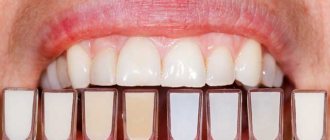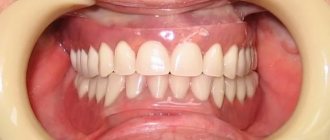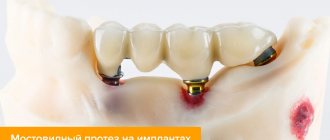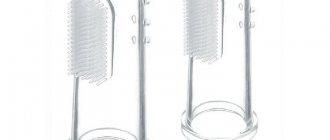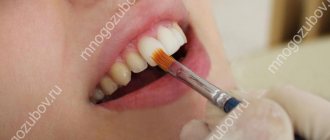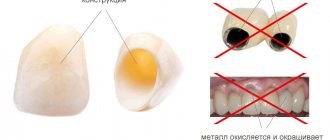What is the difference between a crown and a veneer?
Experts classify both crowns and veneers as orthopedic dentistry, which deals with dental prosthetics. If we talk about the purpose, then in the conventional orthopedic chain “crown-inlay-veneer” the last product is primarily intended to create aesthetics, while crowns and inlays are needed to primarily restore the functionality of the tooth. In dentistry, a separate category is allocated for veneers - microprosthetics, which well reflects the most important visual difference between veneers and crowns. A crown completely copies the entire visible part of a tooth, while veneers model only its outer (vestibular) side.
What veneers and crowns have in common is the fact that both are made in a dental laboratory, but this does not apply to direct composite onlays. In their case, the need for a laboratory stage is eliminated: the application of the composite material is carried out directly in the patient’s mouth, so the procedure does not require taking impressions and is considered an artistic restoration. As for manufacturing materials, there is great variability in crowns. Both designs can be produced from ceramics and zirconium dioxide. However, zirconium veneers are rarely used: zirconium does not adhere well to the teeth, requires significant grinding and looks unnatural.
Braces
Braces, aligners, plates are a tool for correcting uneven teeth and bites. Bite is the position of the teeth on the upper and lower dentition relative to each other when the jaws are closed. An orthodontist is involved in correcting the bite.
Braces or mouthguards move teeth into the correct position: they can eliminate crowding, place dystopic or impacted teeth in the dentition, and straighten the bite.
Stages of treatment with braces:
- Diagnostics (images, casts, photo protocol, preparation of a treatment plan)
- Complete sanitation of the oral cavity (treatment of inflammation, caries, pulpitis, etc.)
- Professional hygiene before installing braces
- Fixing braces on teeth
- Orthodontic treatment (on average - 1.5-2 years, from 10 to 20 visits to the orthodontist to activate the system)
- Retention period (installation of a permanent retainer on the inside of the teeth and wearing a transparent mouthguard to fix the correct position of the teeth)
What is better - veneers or crowns?
Talking about which is better (veneers or crowns) is like comparing a car and a motorcycle. Each of these methods has its own advantages and indications for use. Below is a table that shows situations when it is most preferable to use crowns and when to use veneers.
| Indications for installation of veneers | Indications for crown installation |
|
|
By and large, crowns and veneers have different indications for installation, however, there are situations in which the patient can choose between two products.
Features of the installation process
Before installing veneers, you should consult your dentist. The doctor must tell the patient about all the features of the procedure and how to use dental veneers.
Reconstruction cannot be done in one visit. The duration of recovery depends on the number of teeth.
Stages of installing veneers:
- preliminary examination of the oral cavity;
- selection of the type of linings according to individual characteristics;
- treatment of the tooth surface (removal of top enamel);
- creating an impression for making a plate;
- overlay of temporary veneers (for the period of production of the onlays);
- removal of temporary products;
- installation of manufactured records.
The procedure has a large number of advantages, but there is one disadvantage that often affects patients’ decisions about providing the service - the possible grinding down of the natural crown. This is necessary to align the tooth surface in relation to other teeth. If grinding occurs, the specialist warns the patient in advance.
When is the best time to install crowns?
- With significant tooth decay.
From a functional point of view, crowns are considered a more reliable method, so it is better to cover serious chips and damage with crowns. In addition, veneers are strictly not recommended for pulpless teeth. - Frequent participation in contact sports.
If you cannot imagine your life without hockey, basketball or martial arts, it is better to choose more durable crowns to restore your teeth. - Bruxism and the habit of chewing on foreign objects.
In this case, installing veneers is very risky, but even crowns are not able to withstand such loads for a long time, so you need to get rid of bad habits or consult a doctor to treat bruxism.
Photos before and after installation of veneers
Myofunctional correction
Speech therapist-myofunctional therapist T.B. Zukor conducted an analysis of the functioning of the facial muscles. There was a noticeable imbalance in muscle function. Normalization of muscle tone is necessary, since, firstly, the retainers will have to be removed for about a month for dental restoration, and secondly, after the completion of dental restoration, the issue of maintaining stable results of orthodontic treatment (which was completed in 2021) must be resolved, and here Retainers do not always cope with the task of holding teeth in place (see example of the appearance of a gap between teeth even with a retainer).
Myofunctional exercises were prescribed, which the patient performed before removing the retainer (the correction was carried out in parallel with dental treatment so that the patient did not waste time).
When is the best time to install veneers?
- For small defects in the front teeth.
Unlike crowns, veneers require minimal grinding of the teeth, so the tooth retains its anatomical shape. By the way, it is no longer possible to install veneers after crowns; - To hide small interdental spaces and curvatures.
Veneers cope well with such problems and do not require deep tooth preparation.
When restoring chewing teeth, crowns should be installed, as they cope well with the chewing load. Veneers are placed on molars if they want to get an additional lifting effect for the lower third of the face.
Stage 4. The birth of the smile of our queen - Victoria
The veneers were fixed using an adhesive technique. And in the final photo you see Victoria’s radiant smile:
We received healthy gums, healthy beautiful teeth that are absolutely no different from our own.
Only 4 veneers
, installed on the upper teeth, helped change the smile of the beautiful girl Victoria:
Well, here we go to the clinic, plus another smile from a satisfied and happy patient!
Are veneers used on crowns?
“Is it possible to put veneers on a crown?” — this question is so popular among patients that it has to be discussed separately. The answer here is obvious: veneers are NOT used on crowns. These products are self-sufficient, so such a “mix” makes no sense at all. Repair of crowns is possible, although replacement of the product is more often recommended. Crown restoration is carried out both in the laboratory (the crown is removed beforehand) and directly in the patient’s mouth. The whole procedure is reminiscent of a filling, when the damaged area is filled with a composite material. Veneers cannot be repaired: if the lining breaks, it is replaced with a new one. The exception is direct composite veneers, which can theoretically be restored.
Prevention and hygiene
Preventive examinations by an orthopedist are recommended every 6 months. The doctor monitors the condition of the gums, the appearance of gaps between the teeth and other problems in order to solve them at the very beginning, and not when complications arise. It is also necessary to have your teeth professionally cleaned every 6 months, especially if you have dental implants installed. Removing plaque improves breathing, keeps gums healthy, prevents the development of caries and inflammation at the roots of teeth, so that teeth and implants last a lifetime. Read more about our Teeth for Life program here. Carrying out hygiene at Dial-Dent is a mandatory condition for guaranteeing the treatment performed.
Stage of preparation for treatment
In any orthodontic intervention, it is necessary to take imprints (impressions) of the teeth to construct a three-dimensional model of the jaws, which allows the computer to predict the outcome. Some clinics offer digital scanning when creating a 3D model for aligners.
| Stages | Veneers | Braces | Aligners |
| Creation of a three-dimensional computer model to predict treatment outcomes | 3D modeling allows you to see the result in perspective | The doctor creates a 3D model, the opportunity to see the result with or without removing the eights | Yes |
| Participation of the patient in the discussion of the treatment process and in itself | Participates in choosing the color, shape and material of veneers, but the patient does not participate in the treatment | Does not participate in the discussion of the treatment process or in the treatment itself; the doctor independently, according to indications, corrects the direction of change in the location of the teeth in the jaw | Discusses the course of treatment and its prospects with the doctor, and also participates in treatment, changing aligners, as well as using them all the time |
| Production time | Depending on the material from one day to one month | One or two days | One week |
| Preparing your teeth | Hygienic cleaning is carried out, caries is treated, the enamel is ground down by 0.3-0.7 mm | Plaque and stones are removed, and the enamel is polished for better contact with braces. | Cleaning from stone and plaque |
| Care | Dietary adherence to coloring and solid foods must be changed after approximately 5-10 years | Maintaining hygiene, regular cleaning, using a mouthguard after removing braces at night to consolidate the effect | Cleaning, constant wearing (20-22 hours a day) except during meals, no restrictions on food intake (you just need to remove the aligners) |
| Installation time | One veneer is installed in one hour (with more teeth, more time is required) | Takes up to six hours | One hour |
